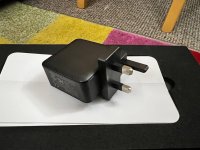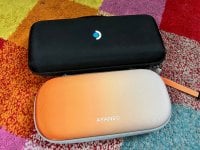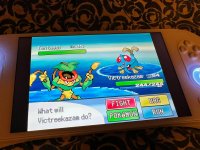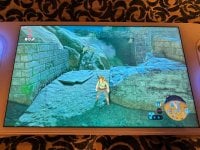 AYANEO 2 (Hardware)
AYANEO 2 (Hardware)
Official GBAtemp Review
Product Information:
AYANEO is a name you should know by now if you're at all familiar with handheld PCs. Coming onto the scene in 2021, they've been fierce competition to GPD with style and polish at the forefront of their devices. Roll on 2023 and the AYANEO 2 is just landing in the hands of early Indiegogo backers. Is it worth a look?
The unboxing experience is the best I've come across in the handheld space, and what you get in the box is pretty good as well. The overall aesthetic matches the device itself, being a fairly sleek white box, with no screws I might add! Inside you have three foam layers featuring the system itself, some paperwork, and finally the included accessories. The system and accessories each come with a sheet plastic layer on top to show you what they are, and I suppose to hold things in place. It looks great and feels great to unpack. In terms of accessories, you get a 65W charging brick and USB C cable, along with three attachments to clip onto the plug. It's a really clean design, with the base plug supporting US sockets, and the three attachments going over it in an incredibly natural way to give you UK, EU, and what I believe is AU plug support. I love that all of these are available to everybody, and it's a plug I'll be keeping for traveling down the line. An added bonus in the box is the inclusion of two USB C to USB A adapters, which does make sense given the device's three USB C ports. Finally, you get a pair of replacement tabs for the console's sides should you decide to open it up and damage them in the process. It's nice that these are included, but the real question to be asked is why there's a need for these to be included. We'll come back to this though.
With the AYANEO 2 being a Windows 11 device, setup is about as easy as you'd expect if you've ever bought a new PC before. There's an argument to be made at this stage about reinstalling Windows if you don't trust the version that's been shipped, but I decided to throw caution to the wind and roll with what was sent to avoid the hassle of having to reinstall the device-specific stuff required to get the most out of the system. With the standard Windows setup out of the way, I was introduced to AYA Space, the software at the centre of the AYANEO experience. I like the idea of it. You get a unified game launcher for your PC storefronts, alongside various applets and customisability for the overlay that's available to you when pressing the dedicated AYA button. When it works, it works fine. It's just incredibly rough around the edges. My biggest issue came with updating the app. Though I managed to get the update downloaded fine, the actual update process was entirely in Chinese (who knows what terms I accepted), and the entire app switched to Chinese once the update had applied. Thankfully for me, this is a common issue, and as such, the process of changing the language back to English is well documented. Having said that, it shouldn't need to be in that way. The device itself looks and feels hugely premium, and small things like this take away from that, if only a little.
Looking to the larger device, it's hard not to be impressed. Between GPD and AYA, two of the big hitters of the handheld PC market, we've seen a huge bout of inspiration taken from Sony's PS Vita. GPD have done a great job of taking on the Vita's form factor, packing incredible power into a smaller form factor that at a glance, could genuinely be mistaken for something of Sony's. AYA went a different route however, taking the OLED Vita's completely-glass face, and boy does the device look and feel great for it. The display is the same size as the Steam Deck's seven inch 16:10 panel. The key upgrade on offer here when compared to a Steam Deck though is that it's 1200p, in oppose to the 800p display you'd find in the Deck. That's not where it stops though. The bezel-less design fits brilliantly in the frame, and looks even better with the glass covering the full face of the system in oppose to just the screen. While it isn't an OLED display, it's definitely one of the nicest ones I've used to date, with some pretty good colour accuracy from what I've seen online (note I don't have the appropriate setup to test this for myself). The only criticism I can find with the full glass face is that it really discourages me from putting a screen protector on. Adding a bump where the screen is just feels really wrong; I wish they offered a full-face screen protector, but I can imagine that'd be a costly custom order.
Despite the AYANEO 2's screen being the same size as the Steam Deck, the system comes in both shorter and thinner. There's a bit of a trade-off here. It's definitely the more portable device, and while the difference isn't huge, I've had a much easier time fitting the AYA in my bag without having to really shuffle things around. What you lose is some of the ergonomics the Deck is heralded for. While the Deck is quite thick, it's pretty much entirely because of how much space the grips take up, and they take up that space for a reason. The AYANEO 2 doesn't feel bad to hold by any means, but if you're coming directly from a Steam Deck, there will be a brief period of adjustment and maybe even discomfort since there just isn't the hold you're used to. Having extensively used the device in the few weeks I've had it, including numerous play sessions of up to eight hours, I can say the form factor is comfortable overall though.
One of the aspects touted most on the Indiegogo page is the hall effect joysticks and triggers, and I can see why. For those who have been out of the loop in the past year, hall effect sensors have become wildly popular in controllers for their increased precision and durability. We've seen them on controllers from 8BitDo, Retroflag, and even on joysticks you can install on your Joy Cons. These are an absolute joy to use, though the travel distance for the triggers might be a bit much for some. The buttons feel good to press and have a decent travel distance, but again with a potential drawback of feeling slightly stiff. They're satisfying, but they fall short in games that require mashing; they're not what I'd want in a pivotal Mario Party minigame. Probably the most divisive aspect of any controller is the D-Pad, and while this one doesn't quite fit my idea of a perfect D-Pad (see the Vita's if you want my favourite), it does a decent job. A lot of my time with the AYANEO 2 has been spent playing D-Pad heavy games, and I've not really come across any notable issues. It pivots well enough, and I've only caught up and down inputs while holding right a few times.
For those paying attention to the images, you'll have probably noticed the two extra buttons in the bottom-right of the face. These represent the AYA button, and a function button respectively. The AYA button will bring up the AYA Space overlay when pressed, and the AYA Space app when held. It's great to have a dedicated button for this, and puts it a step closer to the Steam Deck in gaming usability. I know for a lot of people, Windows as an OS for a handheld like this can be a negative due to its unintuitive nature when paired with a game controller. The flexibility and compatibility of Windows makes it my OS of choice however, and these small software tweaks just make the larger experience smoother. The function button can be mapped using the AYA Space software, but it unfortunately can only be mapped to a set list of functions. These do cover a reasonable spectrum of uses at least, like screenshots, closing an app, and returning to the desktop. I hope in future this can be opened up to allow for key mapping. Outside of the console face, there are actually two more of these function buttons, each sitting next to their respective bumper on the top of the system. Even if I can't map these to be key presses, I do appreciate that you can have separate actions mapped to both pressing and holding each button.
The last big point of interest in terms of the device's build is its screwless design. This is actually a big selling point of the device, and while it does make for a really nice finish all I can really ask is... why? I can't think of a single time I've had a device, premium or otherwise, where accessible screws have been a negative. It looks good, but when it results in a device where you're having to include replacement parts on the expectation you're going to actively be ruining it by trying to open it up? It's not a positive. It's nice the screws are hidden, but they really need to go back to the drawing board if they want this going forwards to come up with a more sustainable design.
Now the burning question on many a mind with any device like this in the modern age will likely be just how it stacks up against the Steam Deck. To this point I've made some passing comparisons. When Valve launched their own system last year, they rocked the handheld world with the sheer value they had on offer, paired with capable hardware and software support you can only really expect from a company as substantial as Valve. Can the AYANEO 2 really stand up to that? Put simply, the answer is no. It's not to say the AYANEO 2 is an inferior product either. In terms of both performance and build quality it wins out hands down, but at the price point it sits at, you would certainly hope it does. This device's cheapest variant is double what the most expensive Steam Deck is, and almost three times the most basic model. For anybody just wanting to get into the handheld PC space, the Steam Deck will likely offer enough. The AYANEO 2 sits in a much more premium space, and I do think it's fine for both of these to exist for different audiences. For those wanting more than the Deck but not quite wanting to spend the $1000+ required for the AYANEO 2, there is a relatively good offering from the AYA team that fills this void in the AYANEO Geek. I unfortunately don't have one of these on hand to give a more thorough look, but at its core you can think of it as a slightly less premium take on the AYANEO 2, with that being reflected in the price. You lose out on the full glass face, and have the option to go down to an 800p display, all while keeping the same 6800U on the inside. The cheapest model of Geek with an 800p display is currently sitting at $100 more than the most expensive Steam Deck. At this price, it offers fantastic value. The issue with this is that this value is an early bird price, and will go up $100 once these units are gone, and a further $100 once the Indiegogo campaign ends. For $749 it's fantastic, but as time goes on it becomes less and less competitive as a natural next step up from the highest-end Deck. That's a shame in my eyes.
Since receiving the AYANEO 2 a few weeks ago, this has become my primary means of both playing PC games and emulation. Given how many options you have available to you on Windows, I thought it'd be a nice idea to just go through how I decided to set things up, and what options you have available to you to make it a more gamepad-friendly OS. In an ideal world, AYA Space would be where this starts and ends, but to some extent I'm glad it isn't. What I love about having Windows over something like SteamOS is the flexibility after all. It's not like I don't use AYA Space, but its use for me is limited to giving me a clean interface for my Steam, Epic, and Game Pass games. I appreciate how easy it is to use, and how it'll just automatically sweep for new games when it's turned on and pull in relevant information. If you're heavily invested in the Steam ecosystem, or perhaps are coming from a Steam Deck, you do have the option of Steam's new Big Picture Mode, which is modelled after the Steam Deck experience. It is missing some features when compared to the full SteamOS, but the compatibility you see from using Windows more than makes up for it in my mind.
In terms of emulation, I decided to try a frontend for the first time. Though many swear by RetroArch, I still prefer the idea of having individual and familiar apps for each console. To this end, I downloaded my go-to emulators console, and used Playnite to tie them all together. It's a great interface that's incredibly easy to setup and maintain. What's more, you can use this with your PC games if you want that library aggregation without AYA's own software. For the first time in maybe ten years, I also installed Rainmeter to make my desktop both touch-friendly and tidy. Though it's just a few icons to launch Steam in Big Picture Mode, load Playnite in its console mode, and take me to my emulation folder, it goes a long way in improving the overall experience.
The device has been great for everything I've thrown at it, and I've tried my best to give it a variety. In terms of emulation, it's handled everything from Game Boy to Switch admirably, though your performance will naturally vary based on your TDP setting. In simple terms, the more power you're willing to use, the better performance you can expect to get out of it. The trade off for this is naturally going to be battery life. Using AYA Space, you have three set TDP configurations: 11W, 15W, and 22W, dubbed power-saving, balanced, and gaming respectively. On top of these, you have a final "pro" setting that you can set manually to be anywhere from 3W to 33W. I tend to have this either set at 6W for easier emulation and indie games, or 33W for the more difficult to emulate titles or certain PC games that push the system to its limits. At each extreme, you can expect around 4 hours of gameplay at 6W and less than an hour if you're pushing it to 33W. Battery life has always been a struggle with x86 handhelds, but I am happy to see it meet my two hour portability threshold at 11W. I find 11W lets me play most of what I wanted if I was willing to make compromises in terms of graphics or framerate. It's not like you need to set things any lower than 800p most of the time anyway, so games will still look fine.
My favourite, albeit somewhat niche, use for the AYANEO 2 is its ability to be an entirely portable Wii U when paired with a portable monitor. Plugging in my ROG Strix XG17AHPE, I had a Wii U in my hands with all the creature comforts. Sure, it doesn't last long without being plugged in, but the fact you could see such a setup on your commute to work if somebody felt that way inclined amuses me to no small extent.
The inclusion of two USB 4.0 ports alongside the USB C 3.2 port means the AYANEO 2 has great potential for a high performance docked setup. If you haven't been keeping up with USB standards, USB 4.0 is the latest in this absurd line, and comes with an impressive list of optional features. Despite being seen as an open implementation of Intel's Thunderbolt protocol, it's actually not a guarantee USB 4.0 has compatibility with eGPUs and other Thunderbolt devices. There's a whole host of other features that may or may not be included when you see USB 4.0 on the box, but at the very least, I can say eGPUs work great with the AYANEO 2. Having a Razer Core X Chroma on hand along with a spare 5700 XT, I was able to see the system at its best. This is what I always wished the Switch would be, even if it is remarkably impractical in terms of cost.
Coming back around to emulation, I really have been quite impressed by what the AYANEO 2 is capable of. In retrospect, much of this shouldn't have been a surprise having owned both a GPD Win 3 and Steam Deck. You have one device that really can just replace a Switch in terms of console gaming, as long as you're willing to accept a compromise in terms of battery life. For comparison, you get somewhere around five hours of play time on Breath of the Wild on the Switch... You'd be lucky to get that idling on the AYANEO 2.
Using Breath of the Wild on Cemu as a bit of a benchmark, here's an idea of what kind of FPS you can expect on various TDP settings at both 800p and 1200p:
| TDP | 800p | 1200p |
| 11W | 34-40fps | 24-32fps |
| 15W | 44-52fps | 32-36fps |
| 22W | 50-54fps | 36-40fps |
| 33W | 50-60fps | 38-42fps |
The above results were using stock settings for the most part, with FPS++ enabled and the resolution altered to the 16:10 800p and 1200p. As somebody who really doesn't mind 30fps in Breath of the Wild, 15W is plenty of power to get what I'm wanting, and the graphical leap from 800p to 1200p is surprisingly significant. What surprised me is the diminishing returns you get when putting in power beyond 15W, with 22W and even 33W really not giving you that much of an improvement when compared to the additional battery drain you're paying. I will add that this test is by no means definitive, and that you can most liikely eck out a solid 60fps if you know your way around Cemu settings better than myself. Breath of the Wild seems one of the toughest to emulate from what I've tried, so you can think of these stats as a bit of a worst case.
Looking at Switch games, you'll find some really variable performance depending on exactly what you're wanting to play. Games like Skyward Sword HD can maintain 60fps in docked mode running as low as 11W, while games like Smash Bros Ultimate will be looking for 22W to hit similar numbers. Despite being a portable system, it really shines at its brightest when you're close enough to a plug to push it to its limits. To me, this isn't as much of an issue as it used to be, but I would still love to see these devices start hitting longevity to rival true handheld consoles now performance is as good as it is.
PC gaming is about as good as you'd expect. Browsing Steam, you can think of the Steam Deck verification as an indication that it'll run on this with no issues at all, and it'll almost certainly run better. I've put a good amount of time into playing Hitman 3, and the idea that a game of that scale can be on a handheld is something I'll never quite get over. At 1200p you won't be hitting 60fps, but you can maintain 30 perfectly well on some pretty spectacular-looking settings. Bumping down to 800p will natutally give you that edge in performance, and is an option you will always have on hand as you decide what you value more on a per-game basis. Running Windows is a huge boon in the native gaming department, completely eliminating issues with the various anti-cheat measures and launchers within launchers some publishers are known for. Though it's definitely a poor use case, I was happy to be playing MapleStory with no problems.
So the burning question remains. Should you pick up the latest AYANEO handheld? If you're on the fence after reading the above, my answer would probably be no, and that's to no demerit of the system as a whole. If you don't already own a Steam Deck, it's just a far more compelling package that I feel companies like AYA and GPD need to be putting more effort into truly competing with. The AYANEO 2 is a super premium device through and through, and that's heavily reflected in the price. Even if the Deck offers better value, I can't deny just how much I've loved using the AYANEO 2. If you have the budget and want more than a Steam Deck, it's one to look at, and definitely not one you'll regret.
Verdict
- Incredibly premium look and feel
- 6800U processor very capable for both PC gaming and emulation
- Incredibly vivid 1200p bezel-less display
- 2x USB 4.0 ports capable of eGPU support (+1 USB C 3.2)
- Cheaper option with same internals available in the AYANEO Geek
- Screwless aesthetic comes at the cost of easy repairability
- Poor battery life (though common amongst x86 handhelds)
- AYA Space rough around the edges













